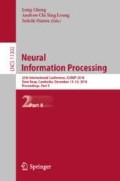Abstract
Unconstrained binary quadratic programming problem is a classical integer optimization problem and is well known to be NP-hard. In order to improve the performance of global optimal algorithms for unconstrained binary quadratic programming problem, in this paper, we proposed a new exact solution method. By investigating the geometric properties of the original problem, the quality of the algorithms for calculating the upper bound and lower bound are improved. And then, for the new derived upper bound algorithm and lower bound algorithm, their recurrent neural network models are proposed and applied respectively in order to speed up the computation. The numerical results shows that the proposed algorithm of a branch-and-bound type is quite effective and efficient.
Access this chapter
Tax calculation will be finalised at checkout
Purchases are for personal use only
References
Garey, M.R., Johnson, D.S.: Computers and Intractability: A Guide to the Theory of NP-Completeness. WH Freeman. Co., New York (1979)
Mcbride, R.D., Yormark, J.S.: An implicit enumeration algorithm for quadratic integer programming. Manage. Sci. 26, 282–296 (1980)
Chardaire, P., Sutter, A.: A decomposition method for quadratic zero-one programming. J. Manage. Sci. 41, 704–712 (1995)
Li, D., Sun, X.L.: Nonlinear Integer Programming. Springer, New York (2006). https://doi.org/10.1007/0-387-32995-1
Helmberg, C., Rendl, F.: Solving quadratic (0,1)-problems by semidefinite programs and cutting planes. Math. Program. 82, 291–315 (1998)
Rendl, F., Rinaldi, G., Wiegele, A.: Solving max-cut to optimality by intersecting semidefinite and polyhedral relaxation. Lecture Notes Computer Science, vol. 4513, pp. 295–309 (2007)
Pardalos, P.M., Rodgers, G.P.: Computational aspects of a branch-and-bound algorithm for quadratic zero-one programming. Computing 45, 131–144 (1990)
Barahona, F., J\({\rm \ddot{u}}\)nger, M., Reinelt, G.: Experiments in quadratic 0–1 programming. Math. Program. 44, 127–137 (1989)
Boros, E., Hammer, P.L., Tavares, G.: Local search heuristics for unconstrained quadratic binary optimization. Technical report, RUTCOR, Rutgers University, Rut-cor Research Report (2005)
Li, D., Sun, X.L., Liu, C.L.: An exact solution method for quadratic 0–1 programming: a geometric approach. Technical report, Chinese University of Hong Kong, Department of Systems Engineering and Engineering Management (2006)
Gu, S., Peng, J.: A neural network based algorithm to compute the distance between a point and an ellipsoid. In: 2015 Seventh International Conference on Advanced Computational Intelligence (ICACI), pp. 294–299. IEEE (2015)
Gu, S., Peng, J., Zhang, J.: A projection based recurrent neural network approach to compute the distance between a point and an ellipsoid with box constraint. In: Youth Academic Annual Conference of Chinese Association of Automation (YAC), pp. 459–462. IEEE (2016)
Yen, Y.: Finding the K shortest loopless paths in a network. Manag. Sci. 17(11), 712–716 (1971)
Bellman, R.: On a routing problem. Quart. Appl. Math. 16, 87–90 (1958)
Gu, S., Cui, R.: An efficient algorithm for the subset sum problem based on finite-time convergent recurrent neural network. Neurocomputing 149, 13 (2014)
Acknowledgments
The work described in the paper was supported by the National Science Foundation of China under Grant 61503233.
Author information
Authors and Affiliations
Corresponding author
Editor information
Editors and Affiliations
Rights and permissions
Copyright information
© 2018 Springer Nature Switzerland AG
About this paper
Cite this paper
Gu, S., Chen, X. (2018). A Neural Network Based Global Optimal Algorithm for Unconstrained Binary Quadratic Programming Problem. In: Cheng, L., Leung, A., Ozawa, S. (eds) Neural Information Processing. ICONIP 2018. Lecture Notes in Computer Science(), vol 11302. Springer, Cham. https://doi.org/10.1007/978-3-030-04179-3_51
Download citation
DOI: https://doi.org/10.1007/978-3-030-04179-3_51
Published:
Publisher Name: Springer, Cham
Print ISBN: 978-3-030-04178-6
Online ISBN: 978-3-030-04179-3
eBook Packages: Computer ScienceComputer Science (R0)

